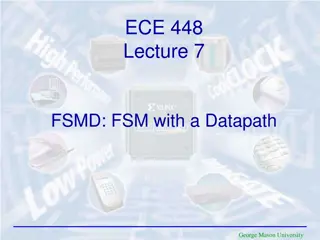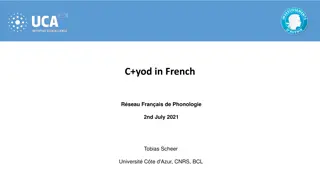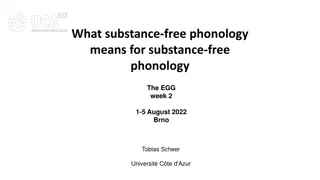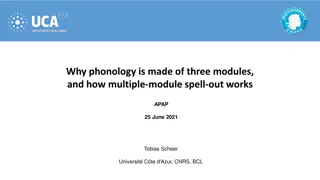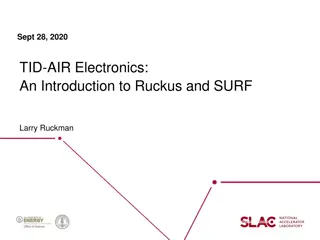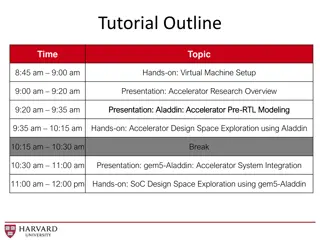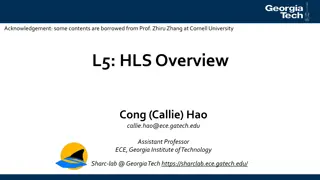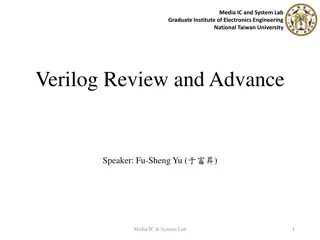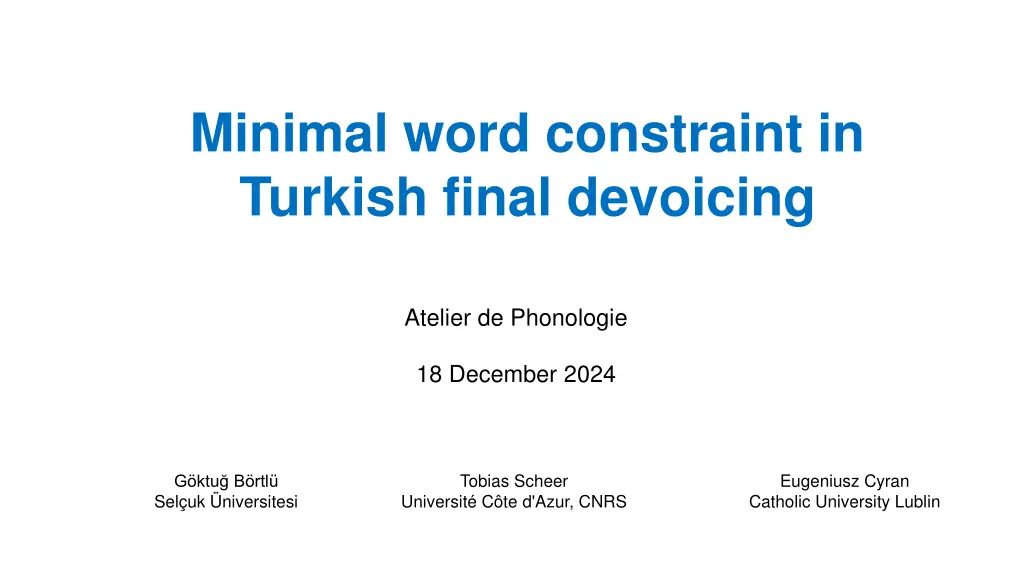
Understanding Final Devoicing Patterns in Turkish
Explore the intricate final devoicing patterns in Turkish compared to other languages like German and Russian. Learn about the devoicing of fricatives, voiced stops in bisyllabic roots, lexically voiceless items, and more in monosyllabic roots. Discover the unpredictability of final devoicing in monosyllabic words and delve into examples of native and borrowed words exhibiting these patterns.
Uploaded on | 0 Views
Download Presentation

Please find below an Image/Link to download the presentation.
The content on the website is provided AS IS for your information and personal use only. It may not be sold, licensed, or shared on other websites without obtaining consent from the author. If you encounter any issues during the download, it is possible that the publisher has removed the file from their server.
You are allowed to download the files provided on this website for personal or commercial use, subject to the condition that they are used lawfully. All files are the property of their respective owners.
The content on the website is provided AS IS for your information and personal use only. It may not be sold, licensed, or shared on other websites without obtaining consent from the author.
E N D
Presentation Transcript
Minimal word constraint in Turkish final devoicing Atelier de Phonologie 18 December 2024 Tobias Scheer Eugeniusz Cyran Catholic University Lublin G ktu B rtl Sel uk niversitesi Universit C te d'Azur, CNRS
1. The pattern 2
Introduction Basic pattern Final devoicing in Turkish is a more intricate pattern than in other final devoicing languages (like German or Russian). fricatives never undergo this process (k z goose.Nom - k z- goose.Acc ) 3
Introduction Basic pattern in bisyllabic (and bigger) roots voiced stops always devoice book.Nom aim.Nom stubborn.Nom garland.Nom kit b- m - in d- t eleng-i book.Acc aim.Acc stubborn.Acc garland.Acc kit p m t in t t elenk Word-final b, , d and g devoice and surface as p, t , t and k respectively in bisyllabic roots. except in some recent loans et d eolog study.Nom geologist.Nom et d- eolo-u study.Acc geologist.Acc 4
Introduction Basic pattern in bisyllabic (and bigger) roots There are also lexically voiceless items in bisyllabic roots. sepet t zjik basket.Nom pressure.Nom curiosity.Nom art.Nom sepet-i t zjik-i mer k- s n t- basket.Acc pressure.Acc curiosity.Acc art.Acc mer k s n t Lexically voiceless Cs are voiceless in both Nom and Acc. 5
Introduction Basic pattern in monosyllabic roots voiced stops may or may not devoice word-finally devoicing items ut edge.Nom t t taste.Nom u -u t d- edge.Acc taste.Acc non-devoicing items s sheet metal.Nom d name.Nom s - d- sheet metal.Acc name.Acc Whether or not a monosyllable undergoes final devoicing cannot be predicted: it is a lexical property of roots. both groups contain native words and borrowings. 6
Introduction Basic pattern in monosyllabic roots The root-final stop may also be lexically voiceless in monosyllabic roots. top s t k t k ball.Nom hair.Nom layer.Nom white.Nom top-u s t - k t- k- ball.Acc hair.Acc layer.Acc white.Acc 7
Introduction spelling IPA j spelling IPA c y t d j monosyllabic native items in our database voiced devoicing Acc. gloss - revenge u -u edge ba - tribute g - force pe -i oven taa - crown ud-u oud sud-u soda ash tad- taste voiced non-devoicing Acc. gloss sa - sheet metal ad- name d- gall kod-u code led-i LED mod-u mode nod-u node ped-i pad lig-i league voiceless Nom. at ip t p ap t p top at et it ot etc. many more Nom. t ut bat g t pet tat ut sut tat native? yes yes no yes no no no no yes Nom. sa ad d kod led mod nod ped lig native? yes yes yes no no no no no no Acc. at - ip-i t p- ap- t p- top-u at- et-i it-i ot-u 9 9 17 4 77 2ndrow numbers: Inkelas & Orgun (1995) count from Moran (1985) Turkish-English dictionary (excluding velars) 8
Introduction spelling IPA j spelling IPA c y t d j zoom on loans that don't devoice CVC CVCVC CVCC voiced non-devoicing Acc. gloss sa - sheet metal ad- name d- gall kod-u code led-i LED mod-u mode nod-u node ped-i pad lig-i league voiced non-devoicing Acc. et d- jeolo-u barkod-u tirend-i puding-i Nom. sa ad d kod led mod nod ped lig native? yes yes yes no no no no no no Nom. et d jeolog barkod tirend puding gloss study geologist barcode trend pudding native? no no no no no Nom. gard alg morg ring Acc. gard- alg- morg-u ring-i gloss guard algae morgue ring native? no no no no 9
Introduction zoom on loans that don't devoice empirical generalizations bigger items (CVCVC and CVCC): only loans, no native words small items CVC: native words present, and also loans bigger items (CVCVC and CVCC) the regular, popular pronunciation is with final devoicing the pronunciation without final devoicing is an option, and is favoured by factors such as high register, higher instruction of the speaker, knowledge of the donor language. small CVC both in native and loanwords, there is no option to devoice: the only pronunciation for all speakers is with a final voiced stop. 10
Introduction zoom on loans that don't devoice we conclude that non devoicing in bigger items (CVCVC and CVCC) is a learned or spelling pronunciation. in small CVC items is a true piece of Turkish phonology thus for our phonological analysis, we only take small non devoicing items into account non devoicing in bigger items is not phonological in kind that means ALL bigger (CVCVC and CVCC) items show final devoicing small CVC items may or may not devoice 11
Introduction summary monosyllabic CVC Acc top-u d- t d- monosyllabic CVCC Acc ft- d rd- bisyllabic (and bigger) root-final C voiceless voiced non-devoicing voiced devoicing Nom top d t t Nom ft d rt Acc sepet-i kit b- Nom sepet kit p take home there are two phonetic items (voiced, voiceless), but three patterns, requiring three laryngeal distinctions. these three distinctions only occur in small CVC items bigger CVCVC / CVCC items have the regular two-way distinction 12
Introduction a word on root-final geminates root-final voiceless geminate stops (as witnessed in intervocalic position in Acc) appear as voiceless non-geminate stops word-finally (in Nom). right.Nom line.Nom h kk- h tt- right.Acc line.Acc h k h t root-final voiced geminate stops (as witnessed in intervocalic position in Acc) appear either as voiced non-geminate or voiceless non-geminate stops word- finallyin Nom in monosyllabic roots. devoicing items et ret predecessor.Nom rejection.Nom edd-i redd-i predecessor.Acc rejection.Acc non-devoicing items h d limit.Nom r b god.Nom h dd-i r bb-i limit.Acc god.Acc 13
Introduction a word on root-final geminates basic phonotactics of Turkish initial: no #CC #CC in loans is repaired: flash > fila , cricket > k riket internal VCCV present with any sonority combination of CC VCC-CV present only if C2 and C3 belong to different morphemes VCCCV in loans is repaired: astronaut > asturonot, electricity > elektirik final: identical to the internal situation VCC# present with any sonority combination of CC, except TR# root-final geminates are TT# clusters, which are licit thus word-final degemination is not due to syllabic restrictions (phonology) rather, it occurs at phonetic interpretation: root-final geminates are phonological geminates also in word-final position they are pronounced as singletons this is not uncommon across languages 14
2. Analyses on the market 15
Literature Balc , E. (2006). A Government Phonology Analysis of Turkish Consonants. Ph.D. Dissertation. Bo azi i University. Brockhaus, W. (1995). Final devoicing in the phonology of German. Linguistische Arbeiten 336. T bingen: Niemeyer. Kopkall , H. (1993). A Phonetic and Phonological Analysis of Final Devoicing in Turkish. Ph.D. Dissertation. University of Michigan. final devoicing is strengthening vs. weakening [uninteresting for us] Brockhaus (1995) also analyzes Turkish devoicing as an example of weakening/lenition: the loss of an L element from the segment. According to Kopkall (1993), Wilson (2003), Nicolae and Nevins (2010), Becker, Ketrez and Nevins (2011), Turkish final devoicing is neutralization and final laryngeal neutralization has often been regarded as a subtype of final weakening in the literature (Hock, 1999; Harris, 2009). For Balc (2006) and Iverson and Salmons (2007), on the other hand, Turkish final devoicing is an instance of fortition. They assume that devoicing is possible with the addition of an H element to the final obstruent. 16
Literature Kaisse, Ellen 1986. Locating Turkish devoicing. Proceedings of the West Coast Conference on Formal Linguistics 5: 119-128. final non-devoicing is due to borrowing Kaisse (1986: 121f) non-alternating voiced stops are exceptions. "dozens, perhaps hundreds of Turkish words are listed in Turkish lexicons as having voiced final stops and affricates. This situation has arisen due to the very large numbers of borrowings from other languages having final voiced obstruents, including Arabic, Farsi, French and English." 17
Literature Inkelas, Sharon & Cemil Orhan Orgun 1995. Level ordering and economy in the lexical phonology of Turkish. Language 71: 763-793. Inkelas, Sharon 1995. The consequences of optimization for underspecification. Proceedings of the North East Linguistic Society 25: 287- 302. [ROA #40]. three-way contrast implemented by three distinct laryngeal catagories Inkelas & Orgun (1995: 776f) [+voice], [-voice] plus underspecified [voice] devoicing items are lexically voiceless and then receive passive voicing in intervocalic position monosyllabic bisyllabic (and bigger) Inkelas & Orgun [-voice] [+voice] [voice] (underspecified) root-final C voiceless voiced non-devoicing voiced devoicing Acc top-u d- t d- Nom top d t t Acc sepet-i kit b- Nom sepet kit p 18
Literature Kallestinova, Elena 2004. Voice and aspiration of stops in Turkish. Folia Linguistica 38: 117-143. Petrova, Olga, Rosemary Plapp, Catherine Ringen & Szil rd Szentgy rgyi 2006. Voice and aspiration: Evidence from Russian, Hungarian, German, Swedish, and Turkish. The Linguistic Review 23: 1-35. three-way contrast implemented by three distinct laryngeal catagories Kallestinova (2004), Petrova et al. (2006) two binary features [ voice], [ spread glottis] devoicing items are lexically voiceless and then receive passive voicing in intervocalic position monosyllabic bisyllabic (and bigger) Kallestinova, Petrova [-voice, -sg] [+voice] [-voice, +sg] root-final C voiceless voiced non-devoicing voiced devoicing Acc top-u d- t d- Nom top d t t Acc sepet-i kit b- Nom sepet kit p 19
Literature Becker, Michael, Nihan Ketrez & Andrew Nevins 2011. The surfeit of the stimulus: analytic biases filter lexical statistics in Turkish lanryngeal alternations. Language 87: 84-125. two-way contrast Becker et al. (2011) Turkish is like other final devoicing languages: it has alternating (voice-voiceless) and non-alternating (always voiceless) items. non-alternating voiced items are dismissed: "barring a few exceptional native words and some loanwords, word-final stops are regularly required to be aspirated" (p.108) no underlying distinctions, but rather lexically specific constraint rankings (p.109f) monosyllabic bisyllabic (and bigger) Becker et al. (2011) constraint ranking X not taken into account constraint ranking Y root-final C voiceless voiced non-devoicing voiced devoicing Acc top-u d- t d- Nom top d t t Acc sepet-i kit b- Nom sepet kit p 20
Literature Erguvanl -Taylan, Eser 2011. Is there evidence for a voicing rule in Turkish? Puzzles of Language: Essaysin Honour of Karl Zimmer, edited by Eser Erguvanl -Taylan & B. Rona, 71-92. Wiesbaden: Harrassowitz. two-way contrast Erguvanl -Taylan (2011) morpheme-final stops are lexically voiced: lexically voicless: devoicing rule applying to /d/ voicing rule (in intervocalic position) applying to /p, / in bisyll. voiced non-devoicing are dismissed, following Inkelas & Orgun (1995): see below. d t, p, (there is no /b, /) = voiced devoicing = voiceless monosyllabic bisyllabic (and bigger) Acc sepet-i Erguvanl -Taylan (2011) monosyll.: no rule applies bisyll.: exceptions to voicing rule not taken into account created by voicing and devoicing rules root-final C voiceless Acc top-u Nom top Nom sepet kit b- voiced non-devoicing d- voiced devoicing d t t t d- kit p 21
3. Size constraint on devoicing 22
Literature Inkelas, Sharon & Cemil Orhan Orgun 1995. Level ordering and economy in the lexical phonology of Turkish. Language 71: 763-793. Inkelas & Orgun (1995) dismiss monosyllabic voiced devoicing items Inkelas & Orgun (1995) have the three-way contrast mentioned earlier, but in fact dismiss monosyllabic devoicing items (p.778) "the virtual nonexistence of alternating final plosives in (C)VC roots " count in bisyllabic recent loans that do not devoice (in red below) monosyllabic bisyllabic (and bigger) Acc sepet-i et d- kit b- Inkelas & Orgun [-voice] [+voice] [voice] (underspecified) root-final C voiceless voiced non-devoicing voiced devoicing Acc top-u d- not taken into account Nom top d Nom sepet et d kit p 23
Literature Inkelas & Orgun (1995) why do they claim that alternating monosyllabic items do not exist? because of their count of monosyllables in the Turkish-English dictionary Moran (1985) recall: voiced non-devoicing: 4 voiced devoicing 17 voiceless 77 they conclude that since 17 is very little as compared to 77, the 17 items are "exceptions" and not real: they won't take them into account for their phonological analysis very strange by itself and wrt to the group of 4, which they do take seriously 24
Literature actual empirical situation vs. Inkelas & Orgun (1995) monosyllabic bisyllabic (and bigger) root-final C voiceless voiced non-devoicing d- voiced devoicing Acc top-u Nom top d t t Acc sepet-i kit b- Nom sepet actual empirical situation t d- kit p monosyllabic bisyllabic (and bigger) Acc sepet-i et d- kit b- Inkelas & Orgun [-voice] [+voice] [voice] (underspecified) root-final C voiceless voiced non-devoicing voiced devoicing Acc top-u d- not taken into account Nom top d Nom sepet et d kit p 25
Literature thus in Inkelas & Orgun's (1995) system, there is an asymmetry: [+voice] items exist in both monosyllabic and in bisyllabic versions but underspecified [voice] items have no monosyllabic instantiation: they only occur as bisyllables they conclude that there is a size constraint on [voice] items: "the systematic exceptionality of (C)VC roots to final plosive voicing alternations is due to their bimoraic size" (p. 779) ==> monosyllables are too small in order to be able to do voicing alternations. monosyllabic bisyllabic (and bigger) Acc sepet-i et d- kit b- Inkelas & Orgun [-voice] [+voice] [voice] (underspecified) root-final C voiceless voiced non-devoicing voiced devoicing Acc top-u d- not taken into account Nom top d Nom sepet et d kit p 26
Literature Inkelas & Orgun (1995) provide support for their size hypothesis monosyllabic CVC roots cannot instantiate voice alternations but monosyllabic CVCC roots can devoicing items d rt h r h rp four.Nom mixed ingredients.Nom war.Nom d rd- h r - h rb-i four.Acc mixed ingredients.Acc war.Acc monosyllabic CVC monosyllabic CVCC Acc ft- ring-i d rd- bisyllabic (and bigger) Acc sepet-i et d- kit b- Ink.&Org. [-voice] [+voice] [voice] root-final C voiceless voiced non-devoicing voiced devoicing Acc top-u d- not taken into account Nom top d Nom ft ring d rt Nom sepet et d kit p 27
Literature Inkelas & Orgun's analysis [-voice] and [+voice] items are lexically specified as such their final consonant is fully syllabified at the root level (in a Lexical Phonology setup) underspecified [voice] items the final consonant is "invisible" at the root level = unsyllabified = floating. it appears as voiced when later on syllabified in an onset, as voiceless when syllabified in a coda 28
Literature there is a general size constraint on Turkish words, which must be minimally bimoraic. therefore monosyllabic CVC items cannot have final invisible = floating consonants their final consonants must be syllabified into a coda in order for the word to achive bimoraicity. their final consonants must be syllabified into a coda in order for the word to achive bimoraicity. being in a coda, they are [-voice] thus monosyllabic CVC items cannot belong to the underspecified [voice] class. Therefore there are no alternating monosyllabic CVC items but monosyllabic CVCC items meet bimoraicity without the final C, which can therefore be invisible = floating monosyllabic bisyllabic (and bigger) Inkelas & Orgun [-voice] root-final C voiceless Acc top-u Nom top Acc sepet-i Nom sepet [+voice] voiced non-devoicing d- et d- et d d 29 [voice] (underspecified) voiced devoicing not taken into account kit b- kit p
Literature Inkelas & Orgun's data selection monosyllables with voiced devoicing final Cs are dismissed without reason. the et d / ring class is not a piece of Turkish phonology: non-devoicing is a learned / spelling pronunciation (see earlier) I&O's analysis is impossible with what we believe is the correct empirical situation monosyllabic CVC Acc top-u d- t d- monosyllabic CVCC Acc ft- ring-i d rd- bisyllabic (and bigger) root-final C voiceless [-voice] voiced non-devoicing [+voice] voiced devoicing [voice] Nom top d t t Nom ft ring d rt Acc sepet-i et d- kit b- Nom sepet et d kit p 30
Literature we believe that the correct generalization is CVCC = CVCVC to all extents and purposes, CVCC behave like bisyllabic (and bigger) roots: both instantiate the regular two-way devoicing pattern known from German, Russian etc.: i.e. they lack the class that makes Turkish special: voiced consonants that refuse to devoice the only thing that needs to be explained is the pattern that makes Turkish special: voiced non-devoicing, which occurs only in CVC items. monosyllabic CVC Acc top-u d- t d- monosyllabic CVCC Acc ft- d rd- bisyllabic (and bigger) root-final C voiceless [-voice] voiced non-devoicing [+voice] voiced devoicing [voice] Nom top d t t Nom ft d rt Acc sepet-i kit b- Nom sepet 31 kit p
Literature Inkelas & Orgun (1995) understood that there is a size restriction on Turkish devoicing but reached this conclusion for the wrong reasons the correct empirical generalization is "voiced stops always devoice iff the root is at least trimoraic" monosyllabic CVC Acc top-u d- t d- monosyllabic CVCC Acc ft- d rd- bisyllabic (and bigger) root-final C voiceless [-voice] voiced non-devoicing [+voice] voiced devoicing [voice] Nom top d t t Nom ft d rt Acc sepet-i kit b- Nom sepet kit p 32
4. Non-devoicing voiced stops are geminates 33
non-devoicing voiced stops are geminates bimoraic size restriction voiced stops always devoice iff the root is big enough, i.e. has moraic theory three moras: codas are moraic CVC = 2 CVCC = 3 Strict CV at least two nuclei, ignoring the final empty nucleus (FEN) either option will do the job CVCVC = 3 Strict CV CVCVC /CVCVC / (two filled nuclei, FEN ignored) CVCC /CVC C / (two nuclei, one filled, the other empty, FEN ignored) CVC /CVC / (one nucleus, FEN ignored) 34
non-devoicing voiced stops are geminates when spelt out by themselves, roots that are to small receive an extra CV unit (grey-shaded below) in order to meet word minimality they geminate their final consonant on this extra CV when a suffix is added (V- or C-initial) the minimal word size is met and no gemination occurs 35
non-devoicing voiced stops are geminates the geminate thus created is virtual recall that final geminates are pronounced singleton: redd-i - ret "rejection" hadd-i - had "limit" [CVC] 36
non-devoicing voiced stops are geminates roots that are big enough do not geminate: CVCVC CVCC 37
non-devoicing voiced stops are geminates the non-devoicing of CVC roots is a consequence of gemination geminates do not devoice (geminate integrity) bigger roots freely devoice because their final C is not a geminate 38
non-devoicing voiced stops are geminates given this analysis, how could voiced devoicing CVC items exist? they also geminate because they are too small, but still they do devoice to see how that works, we need to identify laryngeal classes, identify the process of final devoicing 39
Honeybone, Patrick 2005. Diachronic evidence in segmental phonology: the case of laryngeal specifications. The internal organization of phonological segments, edited by Marc van Oostendorp & Jeroen van de Weijer, 319-354. Berlin: de Gruyter. non-devoicing voiced stops are geminates given the three-way pattern we go along with the original analysis by Inkelas & Orgun (1995) but express it in Laryngeal Realism (of which I&O is a precursor) thus CH= consonant specified for being voiceless CL = consonant specified for being voiced C = consonant unspecified voicing C is passively voiced in intervocalic position, otherwise voiceless monosyllabic CVC Acc top-u d- t d- monosyllabic CVCC Acc ft- d rd- bisyllabic (and bigger) root-final C voiceless voiced non-devoicing voiced devoicing Nom top d t t Nom ft d rt Acc sepet-i kit b- Nom sepet CH CL C 40 kit p
non-devoicing voiced stops are geminates final devoicing corresponds to two distinct phonological configurations an active phonological process delaryngealization = removal of L from CL this cannot be done to a geminate, which is immune against phonological operations phonetic interpretation (= non phonological) of C in non-intervocalic position C is pronounced voiceless no phonological operation here, thus geminates happily devoice. monosyllabic CVC Acc top-u d- t d- monosyllabic CVCC Acc ft- bisyllabic (and bigger) Acc sepet-i root-final C voiceless voiced non-devoicing voiced devoicing Nom top d t t Nom ft Nom sepet CH CL C d rd- d rt kit b- kit p 41
non-devoicing voiced stops are geminates CVC items = final C geminated CH : nothing happens: CH is pronounced voiceless in all contexts CL : L should be but cannot be removed because it is a geminate C : is regularly pronounced voiceless, no phonological operation occurs, thus geminates happily participate monosyllabic CVC Acc top-u d- t d- monosyllabic CVCC Acc ft- bisyllabic (and bigger) Acc sepet-i root-final C voiceless voiced non-devoicing voiced devoicing Nom top d t t Nom ft Nom sepet CH CL C d rd- d rt kit b- kit p 42
non-devoicing voiced stops are geminates CVCVC / CVCC items = final C not geminated CH : nothing happens: CH is pronounced voiceless in all contexts CL : L is removed, producing devoicing C : is regularly pronounced voiceless in final position monosyllabic CVC Acc top-u d- t d- monosyllabic CVCC Acc ft- bisyllabic (and bigger) Acc sepet-i root-final C voiceless voiced non-devoicing voiced devoicing Nom top d t t Nom ft Nom sepet CH CL C d rd- d rt kit b- kit p 43
non-devoicing voiced stops are geminates final devoicing items (kit b- - kitap, d rd- - d rt) are ambiguous CL : L is removed, producing devoicing C : is regularly pronounced voiceless in final position monosyllabic CVC Acc top-u d- t d- monosyllabic CVCC Acc ft- bisyllabic (and bigger) Acc sepet-i root-final C voiceless voiced non-devoicing voiced devoicing Nom top d t t Nom ft Nom sepet CH CL C d rd- d rt kit b- kit p 44
non-devoicing voiced stops are geminates thus the big picture: Turkish is a devoicing language just like German, Russian etc.: ALL lexically voiced Cs undergo final devoicing except that it has final geminates due to minimal word size, which resist devoicing fricatives do not devoice learned or spelling pronunciation of non-native vocabulary may inhibit final devoicing the only special thing about Turkish is the fact that frictives do not devoice the obvious analysis is that all voiced fricatives for some reason are CL: C does not occur in fricatives. but this of course does not explain why fricatives are special, i.e. why they do not occur as C . and Turkish is special yet in another respect: its 3-way laryngeal pattern. 45
5. Laryngeal Realism and VOT 46
Laryngeal Realism (e.g. Avery and Idsardi 2001; Beckman, Jessen, and Ringen 2013; Harris 1994, 2009; Helgason and Ringen 2008; Honeybone 2002, 2005; Iverson and Salmons 1995, 2003) Background LR is not intrinsically linked to any particular phonological framework - Government Phonology / Element Theory (e.g. Harris 1994, 2009), - Optimality Theory / Features (e.g. Helgason and Ringen 2008) It combines some insights of: a. Jakobson, Fant and Halle (1952) - distinctive marking of voice and aspiration languages as [ voice] and [ tense], respectively. No universal [ voice] marking. b. Trubetzkoy (1939) - privativity and markedness (both natural markedness, i.e. phonetically based, and logical markedness, i.e. systemically based, e.g. on the basis of neutralization) c. Lisker and Abramson (1964) phonetic categories [b-p-ph] based on the VOT continuum. 47
Laryngeal Realism (e.g. Avery and Idsardi 2001; Beckman, Jessen, and Ringen 2013; Harris 1994, 2009; Helgason and Ringen 2008; Honeybone 2002, 2005; Iverson and Salmons 1995, 2003) Main assumptions Privativity two-way contrast systems are unmarked (Co) vs. marked (C[Lar]) All languages possess unmarked (Co) obstruents (see typology) which typically correspond to laryngeally neutral [plain voiceless] objects, e.g. [p,t,k] Phonetic markedness = phonological markedness displacement from neutral [p,t,k] due to active phonological category ([b] =CL, [ph] = CH) and conversely: full voicing suggests CLand aspiration points to CH Common laryngeal contrasts [d-t-th] can be explained as categories along VOT continuum 48
Voice Onset Time (e.g. Lisker and Abramson 1964, Cho and Ladefoged 1999; Cho, Whalen and Docherty 2019) VOT and phonetic categories Quantal regions of stability wrt production & perception (Stevens 1972) good categories Sufficiently dispersed (Liljencrantz and Linblom 1972) good systems closure release VOT lag vowel vowel VOT lead t [d] fully voiced [t] voiceless unaspirated [th] voiceless aspirated Neat VOT typology of laryngeal systems 49
VOT (e.g. Harris 1994; Honeybone 2005; Iverson and Salmons 1995, 2003) VOT-based typology and phonological representation in LR fully voiced [d] voiceless unaspirated [t] voiceless aspirated [th] /CL/ /Co/ /CH/ Hawaiian (one-way) - /to/ - Polish (two-way) /dL/ /to/ Icelandic (two-way) - /to/ /tH/ Thai (three-way) /dL/ /to/ /tH/ Hindi (four-way) /dL/ /to/ /tH/ /dL+H/ = [d ] 50







